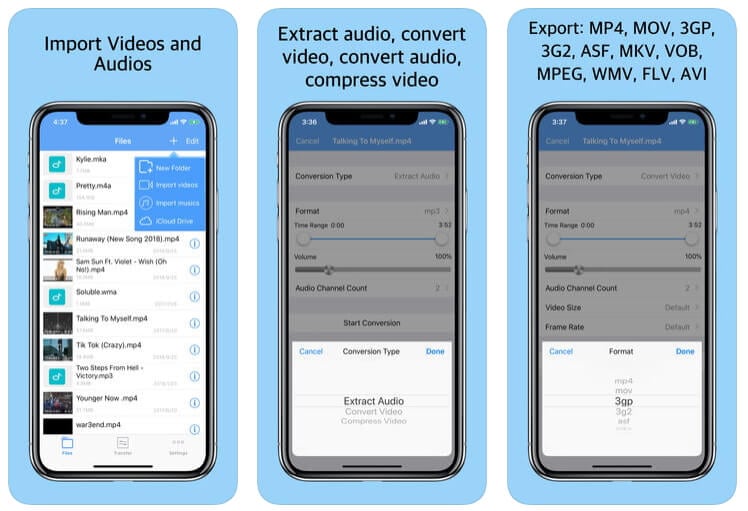"How do you turn a video into an audio file?"
Whether you're looking to save storage space or simply need the soundtrack, learning how to convert video to audio (especially MP4 to MP3) is a must-have skill. This guide shows you the best methods using the top 6 video-to-audio converters, including Wondershare Filmora, free PC software, and the best apps to convert video to audio for your iPhone and Android device.
Top 6 Video to Audio Converters Reviewed
It is also important to know which tools are best for such a kind of conversion and what benefits and downsides they come with if installed on your PC.
That said, here, you will learn how to convert video to audio using six extremely popular and widely used programs.
Watch a Video First to Take a Quick View of These Programs
How to Convert Video to Audio with Filmora (MP4 to MP3) [Windows & Mac]
A product by Wondershare that is one of the most versatile development organizations, Filmora, is available for Windows and Mac platforms. The tool is a full-fledged post-production program that many professionals use because it is lightweight and due to its simple UI and not-so-steep learning curve.
The instructions given below explain how to convert video to audio with Filmora:



Benefits of Using Filmora
Some of the advantages of using Filmora to convert video clips to audio are:
- Easy audio separation from the video
- Ability to export videos directly to audio
- Ability to adjust the audio and remove the background noise
- Ability to record voice and integrate it into the audio clip
Doesn’t have many audio formats for exporting.
At the time of this writing, Filmora supports only MP3 audio format while exporting directly.
Convert Video to Audio Using VLC Media Player [Windows, Mac & Linux]
A well-known application that supports almost all media formats and is available for Windows, Mac, and Linux platforms, the VLC media player has its built-in Converter that can transcode your video clips to audio for free.
The steps given below explain how to make a video into an audio file with VLC media player:



Click Browse from the Destination section to select an output folder, enter a name for the exported file in the Destination file field, and click Start to convert audio to video with VLC media player.
Benefits of Using VLC media player
Some advantages that VLC offers include:
- Doesn’t require any other application to be installed for conversion
- Makes the process quite simple and absolutely free
Doesn’t have editing tools to manipulate the clips before converting.
VLC media player supports OGG (Vorbis), MP3, and FLAC format while exporting.
Convert Video to Audio Using Audacity [Windows, Mac & Linux]
Audacity is yet another cross-platform tool that is specifically dedicated to audio formats and is also used by many professionals to produce industry-standard audio clips. Even though Audacity is an open-source and free program, some new users may find it challenging to understand the interface.
The steps are given below explain the process of converting video to audio with Audacity:

Make the required manipulations to the audio, go to file> Export, and choose your preferred audio format from the list. Choose a destination folder and other output preferences on the Export Audio box, and click Save to convert video to audio with Audacity.
Benefits of Using Audacity
Some benefits that Audacity offers include:
- Granular editing and fine-tuning of audio tracks
- Wide range of output preferences
- Ability to produce industry-standard outputs
- Offers plethora of options and tools to add various effects to the sounds
Some new users may find it challenging to understand the interface. Audacity also needs additional tools to be installed to support video files as inputs.
Audacity supports almost all major audio formats including MP3, OGG, WAV, etc.
Convert Video to Audio Using QuickTime [Mac]
QuickTime is the default media player that comes along with macOS and is installed automatically. Being a proprietary of Apple Inc., QuickTime natively supports all the formats developed by the company, along with some other most popular file types such as MP4, MP3, etc.
To convert a video file to audio with QuickTime on Mac, you can follow the instructions given below:

Benefits of Using QuickTime
Some advantages of using QuickTime to convert video to audio include:
- Mac users don’t need to install any third-party conversion tool or additional plugin
- The conversion process is easy and almost seamless
Doesn’t give any option to choose an output format and doesn’t allow editing the clips either.
By default, QuickTime player converts video files to M4A audio format.
Best App to Convert Video to Audio on iPhone (Media Converter - Video to MP3)
Among several iOS apps that have been developed for video to audio conversion, Media Converter – video to mp3 is one of those that has decent star ratings and user reviews. The app is around 66MB in size and can be obtained from the App Store.
The process on how to convert video to audio with Media Converter is explained below:

Benefits of Using Media Converter
A couple of advantages of using Media Converter to convert video to audio are listed below:
- Eliminates the use of PC or laptop
- Can be obtained easily
- Can be used even while moving
Doesn’t have the flexibility of granular editing as it is there when using a computer program.
The audio formats that Media Converter supports include MP3, M4A, OGG, WAV, FLAC, etc.
Android App to Convert Video to MP3 Free (Video to MP3 Converter)
With around 4.5-star rating on Play Store, Video to MP3 Converter is another app that can convert your video files to audio right on your Android smartphone. In addition, the app also allows basic video trimming that may come in handy while making the entire clip more informative by removing unwanted sections from it.

You can learn how to turn a video file into an audio file with Video to MP3 Converter by following the instructions given below:
Benefits of Using Video to MP3 Converter
Some advantages of using Video to MP3 Converter include:
- It supports every popular video format such as MP4, 3GP, WMV, etc.
- Has simple UI
- Offers various audio bitrates to choose from while exporting
- Allows basic trimming
Doesn’t have many editing options thus, no granular manipulations can be done to the media files while using the app.
Video to MP3 Converter supports MP3 formats at this writing.
Conclusion
Learning how to convert MP4 to MP3 or how to make a video into an audio file is a simple process, and as long as you have a decent computer or an iOS or Android smartphone, you can extract the audio in the format of your choice from the video clips almost instantly. Furthermore, if you are a professional and want to prepare media clips for the clients or your channel, using advanced tools like Wondershare Filmora or Audacity would give you the best conversion experience.
FAQ
-
How can I convert a video to an audio file for free?
You can convert a video to an audio file for free using tools like VLC Media Player, Audacity, QuickTime, Filmora, or online converters. These tools allow you to extract audio from video files and save them in formats such as MP3, M4A, or WAV. -
Can I convert video to audio on my phone?
Yes, you can convert video to audio on your phone using apps like Media Converter (iOS) or Video to MP3 Converter (Android). These apps allow you to extract audio directly from videos stored on your device. -
What audio formats can I convert my video to?
Most tools support popular audio formats like MP3, M4A, WAV, and OGG. For example:- Filmora supports MP3 and WAV.
- VLC supports MP3, OGG, and FLAC.
- Audacity supports MP3, WAV, and OGG.
- QuickTime exports audio as M4A by default.
-
Can I convert multiple videos to audio at once?
Some tools, like Audacity and Media Converter, allow batch processing, which lets you convert multiple videos to audio simultaneously. Check the specific tool’s features to see if batch conversion is supported.


